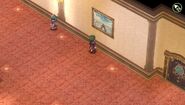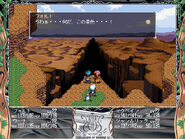mNo edit summary |
Gu4n (Message Wall | contribs) m (Gu4n moved page List of Gagharv references in Kiseki to List of Gagharv references) |
(No difference)
| |
Revision as of 10:33, 19 May 2018
The Kiseki series makes a number of references to the Gagharv series, a trilogy of interwoven The Legend of Heroes games that were released before the start of the Kiseki series.
Hypothetical same world references
- In Trails in the Sky SC, Kevin Graham is seen reading the finale of the book series The Doll Knight for the children of the Mercia Orphanage. This book series was originally a collectible book series in The Legend of Heroes V: Umi no Oriuta. Renne Hayworth, who has read the books herself, repeatedly compares herself and her humanoid weapon Pater-Mater to Princess Tia and the Blue Knight, Pedro, respectively.
- Chapter 1 of The Doll Knight mentions Weltuna, the continent on which Umi no Oriuta takes place.
- Chapter 21 of The Doll Knight mentions the Thirteen Factories, which appears in the Kiseki series as a branch of Ouroboros. Campanella, known to break the fourth wall, also mentions this similarity during Who Wants to Be a Mirannaire?.
- In Trails in the Sky The 3rd, the hallway of the luxury airliner Lusitania features a painting of the eponymous Gagharv, a bottomless gash separating two continents in the world of Gagharv.
Direct references
- The term Esmelas (one of the seven types of septium) originated in The Legend of Heroes IV: Akai Shizuku as Muse's real last name.
- Jenis Royal Academy shares its name with a special healing water that was part of a quest in Akai Shizuku. The Liebe Balm from the Trails in the Sky trilogy shares its name with the Liebe Herb from the same game and treats a similar condition, though the former was localized as Smelling Salts.
- The airship used by the Capua Sky Bandits, the Bobcat, is called the Yamaneko in Japanese, which can be translated as Wildcat. This is also the name of Josette's S-Craft. In The Legend of Heroes III: Shiroki Majo there was a group called the Wildcat Bandits led by playable characters Shirla and Goose. Both groups are better people than they appear at first and end up siding with the protagonists.
- The song "Silver Will" from Trails in the Sky FC takes a large chunk of melody from the song Unforgivable Troublemaker from Umi no Oriuta.
- The face cards in Ruan's Lavantar casino bar include depictions of Julio, Chris and Lodi from The Legend of Heroes III: Shiroki Majo and Avin, Rutice and Michel from The Legend of Heroes IV: Akai Shizuku.
- Anelace Elfead has two direct references to Akai Shizuku, first her Swordwind Slash is identical to a special ability possessed by Douglas and Lucias and second, her family name originally appeared in the Gagharv game in the form of Treasured Sword Elfead. Anelace's appearance is also somewhat similar to Lucias and in a non-Gagharv reference, her armor resembles a feminized version of Adol's 'classic' armor from Falcom's Ys series.
- Loewe's title of Sword Emperor (Bladelord in localization) originally appeared in Akai Shizuku where it belonged to the title character of the Sword Emperor Zamza novels.
- The name Ouroboros appears first in Akai Shizuku as the most powerful water-elemental spirit, before it would go on to represent the secret society in the Kiseki series.
- The spell Blue Ascension in Trails in the Sky SC and Trails in the Sky The 3rd originally appeared in Akai Shizuku as a special ability possessed by Michel which in that game was an enhanced version of the spell Reincarnation. The latter spell itself appeared in Ao no Kiseki as the strongest Space Art. Similarly, Aero Storm from SC/The 3rd originally appeared as a special ability used by Martie and Napalm Breath appeared as a special attack usable by the summoned spirit Kerberos.
- The collectable novels in Trails in the Sky SC and Trails of Cold Steel II are named Gambler Jack. This was one of the aliases used by Thomas in Umi no Oriuta.
- Lloyd and Dudley in the Crossbell games have S-Crafts that were originally used by Gawaine in Akai Shizuku, Meteor Breaker and Justice Hammer respectively.
- Fran has a beloved stuffed animal she calls Ban Ban. He previously appeared in all three Gagharv trilogy games, either as a stuffed animal (Akai Shizuku, Umi no Oriuta) or as Filly's pet bear cub (Shiroki Majo).
- Elie MacDowell's music box in Ao no Kiseki plays the same tune as the music box Chris receives from her mother at the start of Shiroki Majo.
- Tio's second S-Craft is called Zero Field and it grants the Max Guard status effect. In Akai Shizuku, the reward for collecting all of the Sword Emperor Zamza novels was an accessory called Zero Field which gave the bearer complete protection against damage, though the effect was random.
- The White Stones that Lloyd can search for at the Lake Beach originally appeared in Shiroki Majo as a pretty stone said to be found in the Crystal Lake region. In an optional sidequest (omitted from Bandai's PSP remakes) you can visit the region and Chris will make Julio find one for her, in a sequence very similar to Lloyd's hunting for the same stones in Kiseki.
- The Zan Suu enemy from the Crossbell games originally appeared in Akai Shizuku, along with the Dive Eagle enemy. The Deathcargot in the same games originally appeared in Shiroki Majo. The Armored Konpe from SC is a reference to the Konpe series of enemies from Akai Shizuku but doesn't have a direct parallel.
- The Erebonian Folklore books in Trails of Cold Steel discuss legends concerning witches. The game later reveals the existence of the Hexen Clan and part of the plot concerns two witches from this clan working against one another. This has its parallel in the plot of Shiroki Majo, which revolves around two Witches attempting to avert the Wave of Raual but with opposing philosophies about how to do so.
- In Chapter 4 of Trails of Cold Steel, Class VII visits the harbour of Heimdallr. There they run into a boarded ship named Esperanza. This is the second name borne by the Divine Sword of Bardus, from the end of Akai Shizuku to its final appearance in Shiroki Majo.
- To draw additional attention to the name, an Active Voice segment is played in which Machias Regnitz explains Esperanza means 'hope'. In both Gagharv games, Esperanza's meaning is explained by a character.
- The Music Club's performance in Chapter 5 of Trails of Cold Steel is a reference to Umi no Oriuta. The song they play is "Stardust Cantata" from the earlier game and the circumstances surrounding its performance echo those of its performance in Gagharv as well.
- Loa Erebonius in Trails of Cold Steel is known as the 'Ashen Power' and is also described as 'a shadow'. In Umi no Oriuta, the Dark-elemental summon was named Erebonius. This also makes the entire country of Erebonia an indirect Gagharv reference.
- The official English art book of Trails of Cold Steel features an illustration which depicts Olivert Reise Arnor playing a tune on a Fredrik Richter piano, a reference to the character of the same name from Umi no Oriuta.
Thematic Similarities and Indirect References
- The overarching plot of the Kiseki series (involving Ouroboros, the Church and the Sept-Terrion) is the second half of Akai Shizuku's plot (with Octum's Apostles and the Sacred Treasures of Bardus) writ large and a number of characters in the early games have obvious inspirations from Gagharv characters, but much more developed.
- Joshua in Kiseki has a number of similarities to Rutice in Akai Shizuku. Both joined a secret society following the destruction of their hometown and were trained as assassins. Both also consider themselves 'broken' but get over it due to interactions with the rest of the cast and especially with the protagonists who is also their love interest. Both also have nice scarves and use knives. And Joshua was originally conceived as a female character according to interviews.
- Scherazard has several similar personality traits to Muse from Akai Shizuku, along with a similar fashion sense and a preference for whips. Schera's abilities Bind Whip and Queen's Bute (Sadist Whip) originally appeared in the Gagharv trilogy as an ability and a weapon for Muse, respectively.
- Olivier and Muse are both royals who use assumed names to operate undercover and both would rather have fun than take responsibility. Olivier's ultimate motives are however better developed and far more complicated.
- Leonhardt and Kevin both owe some of their characters to Madram from Akai Shizuku. Loewe has a red sword and pulls an impressive heroic sacrifice while Kevin is a holy warrior who experiences a crisis of faith, all of which were first seen in Madram. Both characters have problems relating to a lost love and/or parental surrogate and in Loewe's case Karin's death motivates him in a similar way to how Dominique's death motivates Madram. Rufina herself has some similarities to Dominique by being a member of the Septian Church like Dominique was part of the Church of Bardus. Rufina was also seen as special, though due to her skills and great effort rather than due to being a unique entity.
- The character of Campanella has a predecessor of sorts in the (supposedly fictional) character of Harlequin from the Doll Knight novels in Umi no Oriuta. As those novels appear directly in Kiseki, the link between the two characters may be explicit but this remains uncertain as of Trails of Cold Steel II. Harlequin is a mask-wearing puppeteer who serves as an assassin and speaks in a constantly mocking style. Campanella also speaks in a similar style, he is known as The Fool and he serves as both an observer for the Grandmaster and implicitly (and unofficially) as an assassin if necessary, manipulating events from the shadows like a puppeteer. Adding to the parallels, early concept art of Campanella had him wearing a mask.
- Multiple characters in the Kiseki series share names with and greatly resemble characters from the Gagharv trilogy. These include the MacDowell family maid Joanna (a playable character from Shiroki Majo) and the Crossbell Guardian Force's 'Demon Instructor' Douglas (a playable character from Akai Shizuku)
- The Combat Orbment system in Kiseki is a more developed version of the Resonance Stones from Umi no Oriuta, with both systems being plot-integrated methods of enhancing your characters and learning magic by equipping special stones. Orbments are specifically mentioned as 'resonating' with their users and in the case of the ARCUS model, the users resonating with each other. Combo Crafts and Links have an antecedent in Ensemble Magic.
- The Carnelia books in Trails in the Sky FC are very similar to the Swordswoman Sapphie books from the Gagharv trilogy. Both books are fictionalized accounts of real individuals and in both cases the in-universe author and the individual or individuals serving as the basis for the story are met during the games. Both title characters are also strong female characters who use swords and have nicknames taken from gemstones.
- Ouroboros and Octum's Apostles from Akai Shizuku have some similarities, both being antagonists who are opposed by an organized group of adventurers and the local church and have (or possibly have) more noble goals than their methods would suggest.
- Joshua's second S-Craft and title Black Fang is likely to have been a subtle nod to Mile's strongest special attack from Akai Shizuku when he was acting as one of Octum's Apostles, Black Wing.
- Orbal Arts from Kiseki that have strong nods to magic from Akai Shizuku include Aqua Bleed (to Aqua Splash), Cross Crusade (visually, to Death Quake) and Flare Butterfly and Emma's Craft Aster Flare (to Flare Ghost).
- The Eight Leaves One Blade style in Kiseki is very similar to the nameless style taught by Castor to his students Douglas and Lucias in Akai Shizuku, except that the Kiseki style is far more developed. Both styles share one technique in common, plus a second technique that is almost identical and in both cases, mastery of the style is recognized by the bestowing of the title of Divine Blade.
- The names of two of the Seventy-Seven Devils first appeared in Akai Shizuku as the names of special equipment, Sealed Shield 'Astarte' and Spirit Armor 'Rostrum'.
- Sara is a former high-ranking bracer who was famous for combining lightning with swordplay and has a title to match. Douglas from Akai Shizuku is a high-ranking member of the Adventurers Guild known as 'The Thunderclap' and uses lightning in his attacks. Both wield weapons named for thunder or lightning.
- Kiseki and Gagharv both feature a character named Thomas, who is more important than he appears at first. The two characters somewhat resemble each other, aside from the Kiseki character's glasses.
- The visual effect of Rean using his 'ogre' power (hair turning silver and eyes turning red) are identical to what happened to Mile when he was resurrected as one of Octum's Apostles in Akai Shizuku and both characters have to fight to maintain or regain control of themselves when in this state.
- Ordine, the Azure Knight represents a possible nod to the Blue Knight of the Doll Knight series. The title used to refer to its Awakener personally is identical in Japanese.


